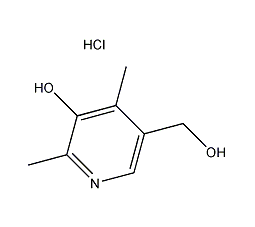
Structural formula
| Business number | 03XF |
|---|---|
| Molecular formula | C8H12ClNO2 |
| Molecular weight | 189.64 |
| label |
2,4-Dimethyl-3-hydroxy-hydroxymethylpyridine hydrochloride, 4-Deoxypyridoxine hydrochloride, 5-(hydroxymethyl)-2,4-dimethylpyridin-3-ol hydrochloride, 4,6-Dimethyl-5-hydroxy-3-pyridinemethanohydrochloride |
Numbering system
CAS number:148-51-6
MDL number:MFCD00051296
EINECS number:205-714-8
RTECS number:UT4800000
BRN number:None
PubChem number:24893236
Physical property data
None
Toxicological data
2. Toxicological data:
1, acute toxicity:Mouse abdominal cavityLD50:150 mg/kg;
Oral administration to chicks LD50: 1570mg/kg
2. Reproductive toxicity: Rat oral TDLo: 11500 ug/kg
Ecological data
3. Ecological data:
Usually for Water is not hazardous and materials should not be discharged into the surrounding environment without government permission.
Molecular structure data
5. Molecular property data:
1. Molar refractive index:42.32
2. Molar volume (m3/mol):127.4
3. Isotonic specific volume (90.2K): 345.2
4. Surface tension (dyne/cm): 53.8
5. Polarizability(10-24 cm3):16.77
Compute chemical data
1. Reference value for hydrophobic parameter calculation (XlogP): None
2. Number of hydrogen bond donors: 3
3. Number of hydrogen bond acceptors: 3
4. Number of rotatable chemical bonds: 1
5. Number of tautomers: 3
6. Topological molecule polar surface area 53.4
7. Number of heavy atoms: 12
8. Surface charge: 0
9. Complexity: 129
10. Number of isotope atoms: 0
11. Determine the number of atomic stereocenters: 0
12. Uncertain number of atomic stereocenters: 0
13. Determine the number of chemical bond stereocenters: 0
14. Number of uncertain chemical bond stereocenters: 0
15. Number of covalent bond units: 2
Properties and stability
Stable under normal temperature and pressure.
Storage method
-20ºC.
Synthesis method
None
Purpose
None
yle=”FONT-SIZE: 9pt; FONT-FAMILY: Arial; mso-fareast-font-family: Arial”>5. Polarizability(10-24cm3):16.77
Compute chemical data
1. Reference value for hydrophobic parameter calculation (XlogP): None
2. Number of hydrogen bond donors: 3
3. Number of hydrogen bond acceptors: 3
4. Number of rotatable chemical bonds: 1
5. Number of tautomers: 3
6. Topological molecule polar surface area 53.4
7. Number of heavy atoms: 12
8. Surface charge: 0
9. Complexity: 129
10. Number of isotope atoms: 0
11. Determine the number of atomic stereocenters: 0
12. Uncertain number of atomic stereocenters: 0
13. Determine the number of chemical bond stereocenters: 0
14. Number of uncertain chemical bond stereocenters: 0
15. Number of covalent bond units: 2
Properties and stability
Stable under normal temperature and pressure.
Storage method
-20ºC.
Synthesis method
None
Purpose
None

 微信扫一扫打赏
微信扫一扫打赏

